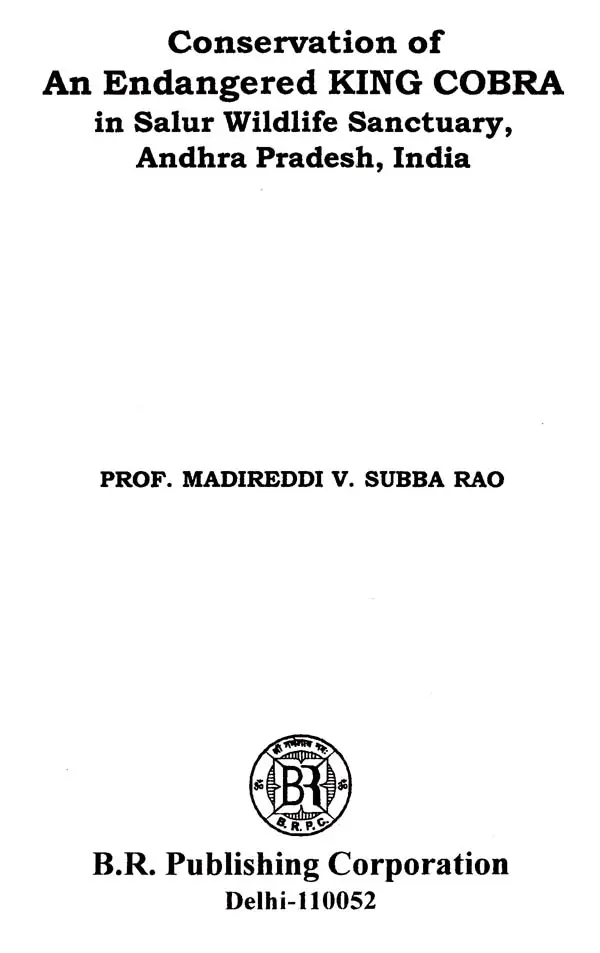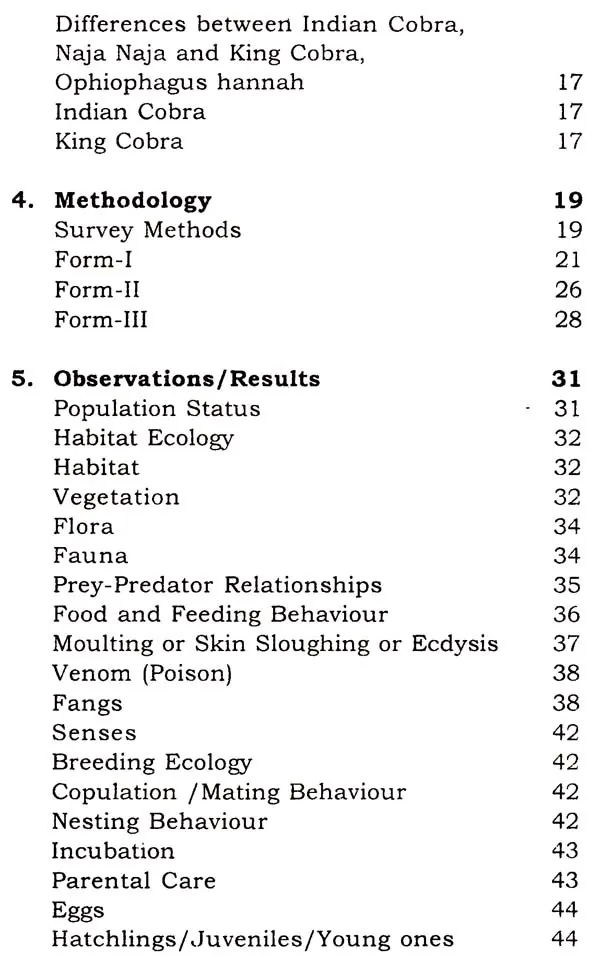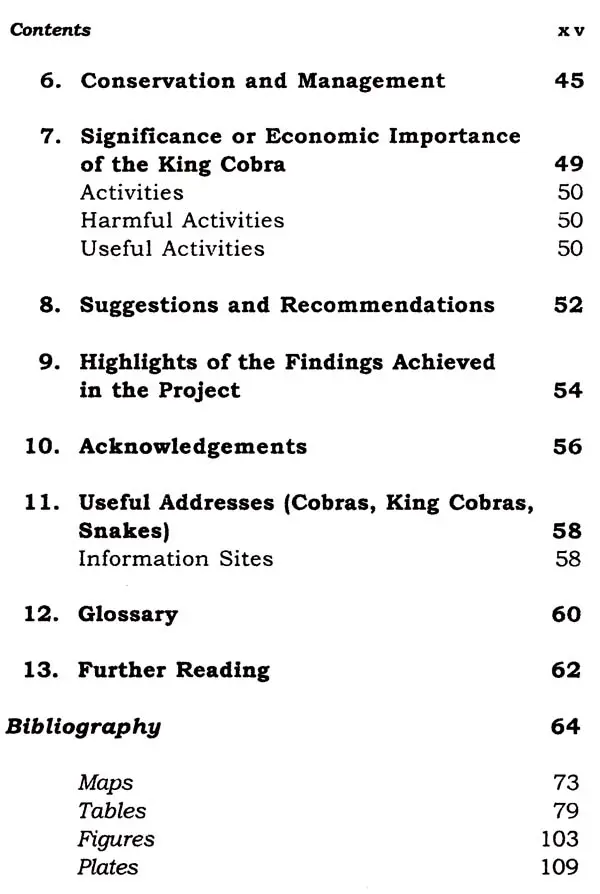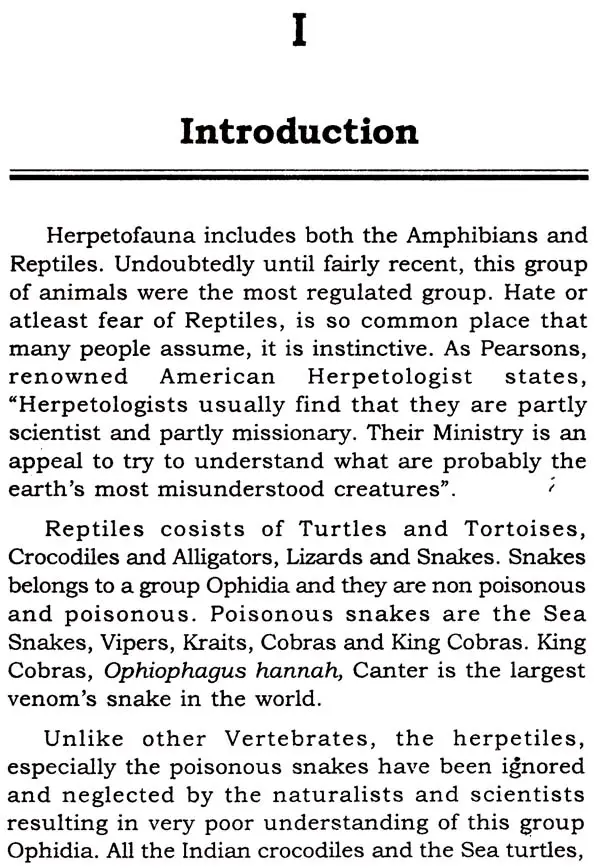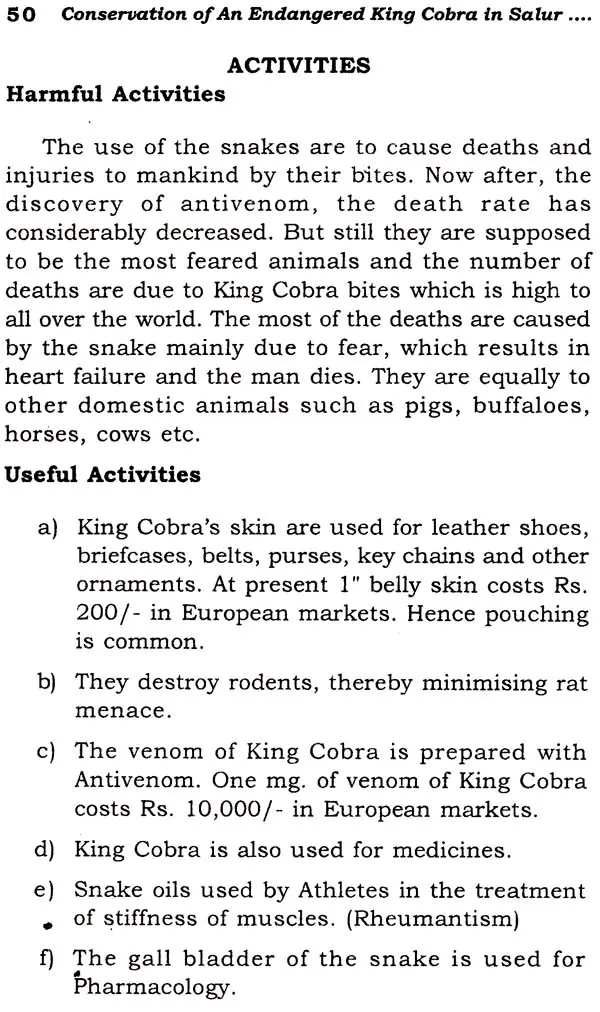
Conservation of An Endangered King Cobra In Salur Wildlife Sanctuary
Book Specification
| Item Code: | UAL023 |
| Author: | Madireddi V. Subba Rao |
| Publisher: | B.R. Publishing Corporation |
| Language: | English |
| Edition: | 2013 |
| ISBN: | 9789350500750 |
| Pages: | 151 |
| Cover: | HARDCOVER |
| Other Details | 9.00 X 6.00 inch |
| Weight | 320 gm |
Book Description
The study are of King Cobras (Hamadryad) includes the Salur and Makkuva Mandals of Vizianagaram District A.P., India. Makkuva and Duggeru bits of Makkuva mandal comprises of an area of 174 Sq.Km. and have 54 Revenue Villages; 29 Panchayats and 40 Hamlets. The population density is 248/1 sq.km. The forest cover is 12.8%.
Data on vegetation types, flora and fauna associated with King Cobra were recorded. The prey and predator relationships, food and feeding behaviour, Moulting, Venom, Breeding Ecology of King Cobra was studied extensively and interpreted approximately.
Population Dynamics, Status, Distribution, Hal at Ecology, Strategies for conservation and management and significance of an endangered King Cobra in Salur Wildlife Sanctuary were studied.
The Conservation and Management Plan of an endangered King Cobra was emphasised and recommendations were proposed to create a Biosphere Reserve in Salur region which are rich in an endangered King Cobras resources.
The author heartily welcomes any criticism and suggestions regarding the contents of the book that would help to revise this Monograph and to make this more applicable.
Dr. Madireddi V. Subba Rao got his M.Sc. Zoology with I Class and I Rank in 1963 from Agra University, Agra; awarded Ph.D. in 1968 from Sri Venkateswara University, Tirupati. He was Post-Doctoral Research Fellow at Creedmoor State Hospital, Queens, New York, USA in 1969 and D.Sc. (IOU, Sri Lanka) in 1997.
He was visiting Professor in Biology, Hofstra University, Hempstead, L.I., New York, U.S.A. (1969) and worked as a Postgraduate Lecturer in Zoology from 1970 to 1978, at Utkal University, Bhubaneswar, Orissa. He worked as Senior Professor, Chairman and Coordinator, Department of Environmental Sciences, Andhra University, Visakhapatnam, India and retired in 2001. Now he is a President in Environmental Research Academy, International (EnRA).
He had published about 260 Technical and Scientific papers in Indian and International Journals, 33 Ph.D.'s and 12 M.Phil. Degrees were awarded under his able guidance to date. He had successfully completed 14 major research projects sanctioned by UGC, World Bank, CSIR and DOEN. He wrote 16 books. He is the Member, IUCN. SSC/Crocodile Specialist Group, Geneva and also member of CBSG (IUCN). He is a Hon. Life member in Sea turtle Preservation Society, Florida, USA.
In recognition of his achievements in contemporary research, National Environmental Science Academy, New Delhi awarded him a Best Scientist for the year 1986 and decorated him with a Gold Medal and in 1991, the Andhra University recognized the research talents of Prof. Rao and awarded him the Best Research Scientist and ISEAS, Bangalore with Gold Medal in 1997, American Biographical Research Inc., USA has nominated him as International Distinguished Leader in 1996, 1997. His name was placed in Asia's Who's Who, Man of Achievement, 1996, 1997, 2000. He was awarded a gold medal for best Zoologist by ZSI in 2004 and AJRA in 2009. He is a Peer committee member in NAAC.
Dr. Rao was a working group member in Eastern and Western Ghats Research projects, Ministry of Environment & Forests, Govt. of India, New Delhi and Member (Environment), UGC, New Delhi. He is a consultant for Environmental Impact Assessment, NTPC, Vamsadhara, YRP, Visakhapatnam Port Trust, NFCL, GFCL, Spectrum, Kakinada Sea Ports Ltd., etc..
For his research studies especially in Ecology, Wildlife biology and for participating in seminars and symposia, he had visited USA, UK, Australia, Singapore, Malaysia, Austria, Italy, France, Greece, Canada, Switzerland, Iran, Germany and Sri Lanka.
The class Reptilia includes the Turtles, Tortoises, Crocodiles, Alligators, Lizards and the Snakes. India consists of 428 Reptiles and 156 are endemic. There are 216 species of snakes in India of which 52 varieties of poisonous snakes. The King Cobra, Ophiophagus Hannah, Canter is the second largest snake after the Python and the first deadly venomous snake of the World. It is instinctive that most of the people hate and get fear about such endangered and threatened species of King Cobra.
Due to lack of sufficient information on King Cobra even in major regions like Eastern Ghats, there is a need to update and substantiate more information on King Cobra. The aim of the study is to identify and document the Status, Distribution, Habitat Ecology and Strategies for the conservation of the King Cobra, which is in list of endangered species. The study reveals the need of protecting King Cobra and to contribute baseline information for their conservation and management as well as adopting conservation measures in view of the tribal development and depletion of the Eastern Ghat forests of Salur region of Andhra Pradesh.
Herpetofauna includes both the Amphibians and Reptiles. Undoubtedly until fairly recent, this group of animals were the most regulated group. Hate or atleast fear of Reptiles, is so common place that many people assume, it is instinctive. As Pearsons, renowned American Herpetologist states, "Herpetologists usually find that they are partly scientist and partly missionary. Their Ministry is an appeal to try to understand what are probably the earth's most misunderstood creatures".
Reptiles cosists of Turtles and Tortoises, Crocodiles and Alligators, Lizards and Snakes. Snakes belongs to a group Ophidia and they are non poisonous and poisonous. Poisonous snakes are the Sea Snakes, Vipers, Kraits, Cobras and King Cobras. King Cobras, Ophiophagus Hannah, Canter is the largest venom's snake in the world.
Book's Contents and Sample Pages
